Tie Breakers for all games can be found here.
2025 HOT NEW GAME: POPCORN
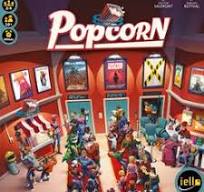
Designer: Victor Saumont
Publisher: IELLO
BoardGameGeek info: Popcorn
GM: John Weber
Number of Players: 3 – 5
Learn & Play demo: Fri 7:30 – 9:00 pm
In Popcorn, each player manages their own movie theater and tries to show the best combination of movies in order to attract guests to their seats.
The game plays out over nine rounds, and in each round you may acquire a new movie, build or upgrade your theater, and use advertising to attract new guests — then it’s showtime, with you drawing guests at random from your bag to see who has shown up. Place guests in the right seats to activate special powers; match them with the right movies, and you get a movie bonus as well, thanks to their enthusiasm for your good taste.
The bonuses from a movie get worse the longer it runs, so be sure to bring in fresh films to keep guests on the edge of your seats. After all, happy guests can help your theater win awards in town; more importantly, they can keep the “popcorn” piling up in your coffers, and whichever theater owner fills their popcorn box the best wins.
LIGHTNING TRAIN
 Designer: Paul Dennen
Designer: Paul Dennen
Publisher: Dire Wolf
BoardGameGeek info: Lightning Train
GM: Legend Dan, Canton Games
Number of Players: 3 – 4
Learn & Play demo: Thurs, 1:30pm
Steer your railway company through a land of strategic opportunity in the bag-building train game Lightning Train.
Build your bag to improve your company’s resources, then place your chips to open stations and train lines across eight regions of North America. There’s a fortune to be made by delivering goods to the cities that need them…but will you work together, or look to cut out the competition? Which stations do you need to secure a route to victory? How can the powerful lightning trains accelerate you past your rivals?
Purchasing new chips opens up new strategic opportunities – but always at a cost! – and getting the most value out of the deliveries available requires balance and careful planning.
ROCK HARD 1977

Designer: Jackie Fox
Publisher: Devir
BoardGameGeek info: Rock Hard 1977
GM: John Weber
Number of Players: 3 – 5
It’s 1977. You’re an up-and-coming musician, dreaming of making it big with your band. Over the next few months you’ll rehearse, play gigs, write songs, and promote your band. With careful planning and a little luck, you’ll earn the most fame and become the best new artist of the year.
GREAT WESTERN TRAIL: EL PASO
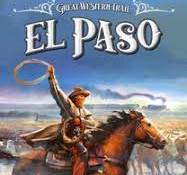
Designer: Johannes Krenner, Alexander Pfister
Publisher: Lookout Games
BoardGameGeek info: GWT: El Paso
GM: Eric Wrobel
Number of Players: 3 – 4
Demo: Wed, 4:30
El Paso is mechanically based on its predecessors in the Great Western Trail trilogy. In Great Western Trail: El Paso, you take on the role of the ranchers of that time and bring your best cattle to El Paso to earn money and victory points. Hire more cowboys, builders, and engineers to get closer to your goals: Buy cattle to increase the value of your herd!; Construct buildings to unlock more actions!; Participate in the expansion of the railroad and secure the most attractive contracts!
FINSPAN
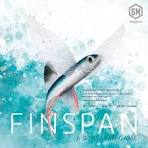
Designer: David Gordon, Michael O’Connell
Publisher: Stonemaier Games
BoardGameGeek info: Finspan
GM: Richard Pearl
Number of Players: 3 – 5
Learn & Play demo: Thurs, 1:30pm
You are a marine researcher seeking to find and observe an array of aquatic life in the colorful Sunlight Zone, ghostly Twilight Zone, and pitch-black Midnight Zone of the world’s seas and oceans. In Finspan, the fish you discover over four weeks will generate a series of benefits as you dive deeper into the ocean.
MOON COLONY BLOODBATH
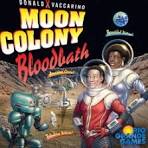
Designer: Donald X. Vaccarino
Publisher: Rio Grande Games
BoardGameGeek info: Moon Colony Bloodbath
GM: Linda Pollnitz
Number of Players: 3-5
Learn & Play demo: Wed, 6pm
Moon Colony Bloodbath is an engine-building, engine-losing tableau game, with a shared deck the players build that makes things happen, many of them bad things that kill people in your moon colony, but some positive, and some that let you build up. But whatever can go wrong will go wrong.
The game lasts until one player’s moon colony has no people remaining, or until the players reach the bottom of the event deck. At that point, the player with the most survivors wins
PATH OF CIVILIZATION

Designer: Fabien Gridel
Publisher: Captain Games
BoardGameGeek info: Path of Civilization
GM: John Weber
Number of Players: 3-5
Take the reins of your Civilization and make the choices that will make it the most prosperous. It doesn’t matter which path you take, as long as it leads your people to glory. Research new technologies to improve your nation’s Science, Military strength, Spirituality, Culture and Industrialization.
SETI: SEARCH FOR EXTRATERRESTRIAL INTELLIGENCE
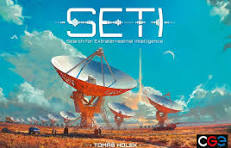
Designer: Tomas Holek
Publisher: Czech Games Edition
BoardGameGeek info: SETI: Search for Extraterrestrial Intelligence
GM: Imran Akram
Number of Players: 3 – 5
Learn & Play demo: Wed, 7:30pm
In SETI: Search for Extraterrestrial Intelligence, you lead a scientific institution tasked with searching for traces of life beyond planet Earth. The game draws inspiration from current or emerging technologies and efforts in space exploration. Players will explore nearby planets and their moons by launching probes from Earth while taking advantage of ever-shifting planetary positions. Decide whether to land on their surface to collect valuable samples, or stay in orbit for a broader survey. Additionally, by directing your telescopes to gaze into distant star systems, you may detect traces of alien signals or undiscovered exoplanets, and collect promising data to examine and study back home.
HARMONIES
Designer: Johan Benvenuto
Publisher: Libellud
BoardGameGeek info: Harmonies
GM: Chris Wildes
Number of Players: 3 – 4
In Harmonies, build landscapes by placing colored tokens and create habitats for your animals. To earn the most points and win the game, incorporate the habitats in your landscapes wisely and have as many animals as you can settle there.
LET’S GO! TO JAPAN

Designer: Josh Wood
Publisher: Alderac Entertainment Group
BoardGameGeek info: Let’s Go! To Japan
GM: Linda Pollnitz
Number of Players: 3 – 4
Learn & Play demo: Fri, 5pm
In Let’s Go! To Japan, you are a traveler planning, then experiencing your own dream vacation to Japan.
Players draw activity cards illustrated by Japan-based artists and strategically place them in different days in their week-long itinerary. These can’t-miss tourist attractions will have you bouncing between Tokyo and Kyoto as you try to puzzle out the optimal activities to maximize your experience while balancing your resources. The game ends with a final round in which you ultimately go on your planned trip, activating each of your cards in order along the way.
APIARY
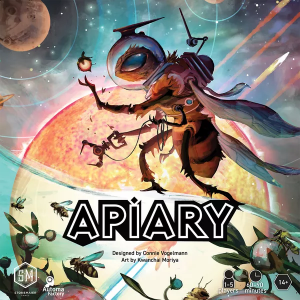
Designer: Connie Vogelmann
Publisher: Stonemaier Games
BoardGameGeek info: Apiary
GM: Chris Wildes
Number of Players: 3 – 5
In Apiary, each player controls one of twenty unique factions. Your faction starts the game with a hive, a few resources, and worker bees. A worker-placement, hive-building challenge awaits you: explore planets, gather resources, develop technologies, and create carvings to demonstrate your faction’s strengths (measured in victory points) over one year’s Flow. However, the Dearth quickly approaches, and your workers can take only a few actions before they must hibernate! Can you thrive or merely survive?
FOREST SHUFFLE
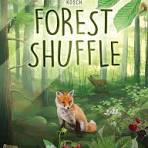
Designer: Kosch
Publisher: Lookout Games
Boardgamegeek Info: Forest Shuffle
GM: Linda Pollnitz/Bob Oliver
Number of Players: 3 – 5
Demo: Forest Shuffle-Dartmoor Wed, 6:30pm
In Forest Shuffle, players compete to gather the most valuable trees, then attract species to these trees, thus creating an ecologically balanced habitat for flora and fauna.
Cards depict either a particular type of tree or two forest dwellers (animal, plant, mushroom, etc.), with these latter cards being divided in half, whether vertically or horizontally, with one dweller in each card half. On a turn, either draw two cards — whether face down from the deck or face up from the clearing — and add them to your hand, or play a card from your hand by paying the cost, then putting it into play.
Look for scoring synergies between cards, but don’t take too long: winter is coming! When the third winter card is drawn from the bottom third of the deck, the game ends immediately. Players tally their points based on the trees and dwellers in their forest. Whoever scores the most points wins.
Note: All expansions and the Forest Shuffle Dartmoor game may be played.
INK
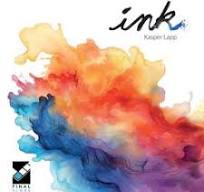
Designer: Kasper Lapp
Publisher: Final Score Games
BoardGameGeek info: Ink
GM: Marcy Morelli
Number of Players: 3 – 4
Learn & Play demo: Thurs, 11:30am
INK invites you to deploy your talent by creating sumptuous paintings worthy of the greatest collections.
Combining tile placement, resource and hand management, and pattern recognition, Ink challenges players to complete high-value contracts by carefully placing ink tiles to form harmonious patterns. The trick lies in balancing spontaneity with planning, every move you make affects not only your current canvas, but the options you’ll have in future turns.
.SEA SALT & PAPER
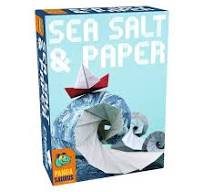
Designer: Bruno Cathala, Theo Riviere
Publisher: Bombyx
Boardgamegeek Info: Sea Salt & Paper
GM: Meredith Martini
Number of Players: 3 – 4
Learn & Play demo: Thurs, 9pm
This unique & fast-paced card game is played in rounds until one player reaches the required number of points for victory. To win points,
you must carefully choose the cards you take and use their effects wisely. Catching
your opponents off guard could also be a good strategy. During your turn, you assemble your hand, maybe place cards for their effect, and decide if you want to end the round. But do you think you are the one with the most points in hand?
OBSESSION
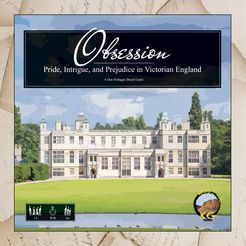 Designer: Dan Hallagan
Designer: Dan Hallagan
Publisher: Kayenta Games
BoardGameGeek info: Obsession
GM: John Weber
Number of Players: 3 – 5
You are the head of a respected but troubled family estate in mid-19th century Victorian England. After several lean decades, family fortunes are looking up! Your goal is to improve your estate so as to be in better standing with the truly influential families in Derbyshire.
Players should be aware that there are several published variants as well as several “Expert” variants that have been posted on Boardgame Geek. Furthermore, since this game debuted at EuroQuest in 2018, a second edition with a major expansion (Upstairs/Downstairs) has added an additional dimension to the game, along with user-generated content such as additional Gentry cards and improvement tiles. Players should feel free to use any combination of these — since this is the Wild Card event, anything goes, i.e., any variant that all players agree upon is acceptable.
CAN’T STOP
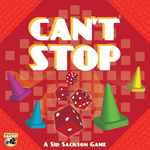 Designer: Sid Sackson
Designer: Sid Sackson
Publisher: Parker Brothers, Franjos Spieleverlag,
BoardGameGeek info: Can’t Stop
GM: Chad Martin
Number of Players: 3 – 4
In this Sid Sackson classic, there is a board with all the possible results of two six-sided dice: two through twelve. The object of the game is to move a little marker to the top of three columns by rolling that result, but you need many more sevens than you need twelves, based on the likelihood of each result. During your turn, you roll the dice and place temporary markers onto the board. You can continue moving these markers until either none of your dice match (your turn is over and all progress you’ve made is gone), or cut your losses and end your turn (placing a permanent marker in your rows). Nice light filler for opening or closing a session.
LOST CITIES
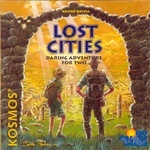 Designer: Reiner Knizia
Designer: Reiner Knizia
Publisher: 999 Games, Rio Grande Games
BoardGameGeek info: Lost Cities
GM: Chad Martin
Number of Players: 2
Lost Cities is a card game from the Kosmos two-player series. The object is to mount profitable expeditions to one or more of the five different lost cities. Card play is quite straightforward, with a few agonizing moments sprinkled through what is mostly a fast-moving game. If you start a given expedition, you’d better make some progress in it, or it’ll score you negative points. If you can make a lot of progress, you’ll score quite well. After three rounds, the highest total score takes the day.
Rules Clarification
Three hands must be completed for an official game. As per the rules, highest aggregate score will determine the winner.
VEGAS SHOWDOWN
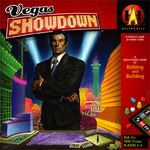 Designer: Henry Stern
Designer: Henry Stern
Publisher: Avalon Hill (Hasbro)
BoardGameGeek info: Vegas Showdown
GM: Eugene Yee
Number of Players: 3 – 5
Players compete to build the most famous hotel/casino. Room tiles representing slot machines, lounges, restaurants, and other casino-related places appear on a central board and the players hold auctions to win the rights to have those rooms in their building, garnering them income, population, or fame. Bidding wars escalate, values fluctuate, and designers renovate until finally the hotel/casinos are put to the test to determine whose garners the most fame.
Rules clarifications:
1. There is a confirmed (with the game designer) misprint on one of the Sports Book tiles. There should be two “A” tiles and one “B” tile. Before game play, take one of the “B” Sports Book tiles and shuffle it into the “A” pile. Place the “A” tiles underneath the “B” tiles and draw from the bottom of the stack. After the improperly marked “B” Sports Book is revealed, place the remaining A tiles back on top and draw from the top of the stack going forward.
2. If the Event card “Lower Prices” is pulled when a Prestige tile is at the minimum bid of 3, that tile is to be discarded and a new one
drawn immediately, using a new Event card to determined which stack to pull from.
3. If two Taxes events are drawn, the effect is not stacked. Income for everyone is halved, not quartered.
4. If two Visionary events are drawn, the effects are stacked. (i.e. gain 2 fame per overbid)
5. If two Good Relations events are drawn, the effect is not stacked. The effect is the same as if one was drawn.
Tie-breakers: Follow the tiebreakers in the standard rules and, if still tied, furthest away from start player is the winner.






 Designer: Dan Hallagan
Designer: Dan Hallagan









